For Ted, not only did the visual effects crew have to bring to life a cuddly, furry teddy bear as a CG animal, they also had to make him naughty – an edge infused into the character by director and Family Guy creator Seth MacFarlane. We break down how the film was ‘stuffed’ with effects using on-set motion capture by MacFarlane himself and a shared effects effort from Tippett Studio and Iloura, overseen by the The Creative-Cartel, and how the VFX supe got to go one-on-one with Mark Wahlberg.
It started with a test
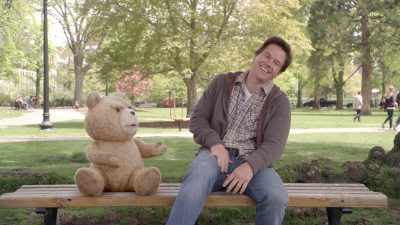
Visual effects producer Jenny Fulle’s production service company The Creative-Cartel oversaw Ted’s effects, putting together the teams of artists from Iloura in Melbourne, Australia and Tippett Studio in Berkeley, California. Fulle had recently been the visual effects producer on other successful global effects collaborations on films such as Ghost Rider: Spirit of Vengeance and Priest, with The Creative-Cartel having a virtual studio approach to production. Fulle had meetings with Macfarlane who knew early on that motion capture would be his preferred approach to giving Ted the right personality.
“We were given a single Photoshop image of Ted as concept art,” recalls overall visual effects supervisor Blair Clark. “Iloura did a test where they took some early mocap data that Seth had done, and an early model of Ted and they shot some plates. Iloura’s test was amazing – everybody fell in love with it because it was ‘just’ Ted. They just completely hit on the character and the look and it became the standard to follow.”
The visual effects shots were then split almost exactly evenly between Iloura, under visual effects supervisor Glenn Melenhorst and Tippett Studio, under VFX supe Scott Liedtka, with each shop given essentially whole sequences to work on, but maintaining close collaboration via The Creative-Cartel for a consistent animation and fur look.
– Above: watch Iloura’s making of reel for Ted.
The mocap set-up
Armed with essentially that same design from Iloura’s test, principal photography commenced. The on-set approach involved the use of a stuffie Ted stand-in and several reference and lighting passes, but also crucially the voice of Ted – MacFarlane – was there delivering lines and, for many scenes, he would also don an Xsens MVN motion capture suit to provide the character’s gross movements.
“Every time we had Ted and an actor together doing a dramatic scene, Seth wore the MVN suit,” says Clark. “He was just out of frame, but they could hear him and react. This meant he had a kind of spontaneous proximity with the actors, which translated to the animators as well because they could pick up on that, rather than trying to figure out the pantomime later.”
The MVN suit provided real-time feedback, via Motion Builder, to an on-set monitor. “After the first couple of days, Seth was in the groove and knew the routine,” notes Clark. “He was really body aware and was really good at pantomime.” Ultimately, the mocap data and accompanying reference video was incredibly useful for the overall animation and then augmented with keyframe by both Tippett and Iloura. “We tried not to deviate from the mocap very much, just to fix some of the obvious issues from having different proportions. Webster Colcord worked on the production side going through the motion capture and did a lot of clean up before sending it through to the VFX shops.”
On-set interaction
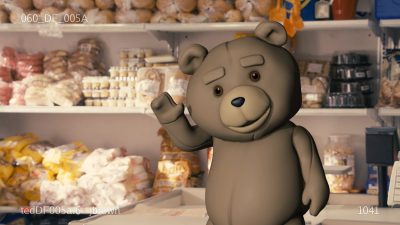
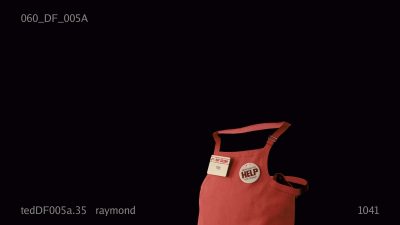
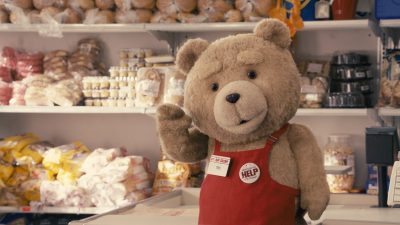
The Ted stuffie was essentially a real teddy bear with some posable joints and a loose neck. It was fitted with an aluminium rod that could be puppeteered. “We would block the scene with the actors so they had a sense of how big he was,” explains Clark, “where he was and approximately what he was doing. Seth would do the lines during that rehearsal. I would follow along with the stuffie as best I could. We would shoot that as well, serving as a lighting reference and as a rehearsal.”
“After that take we’d pull the stuffie out and replace it with an eyeline tool,” adds Clark, “which was basically a stick with two little eyeballs on it. That was small enough so that it would be covered by the CG bear or we could paint it out. We also used chrome balls, shot a color chart and used a Civetta camera for the HDRs, which we could also shoot in two different positions and use for photogrammetry.”
If Ted was sitting on a couch or bouncing a bed, the reference pass would also include some physical interaction. “I had two little furry covered rods capped with approximations of Ted’s hands,” says Clark. I would poke the lounge or sheets or whatever he would deform, and try and poke it with the same amount of weight he would give. We could use that as reference or extract the area and use it in a comp.”
For one series of shots in which Ted has a play punching fight with his long-time owner and friend John (Mark Wahlberg), the on-set interaction required Clark to jab the actor with the rods as reference. But this was nothing, in terms of what Clark had to do to Wahlberg, compared to a later scene in which Ted and John have a fight in a hotel room. “Ted grabs an antenna off a clock radio and runs over and pulls Mark’s pants down and starts whipping his ass with it,” says Clark.
“That’s all good and fine but I had to do the reference pass for that! I went in thinking it’ll be the stunt double, but I walk in and it’s Mark laying there with his bare butt exposed. I had the radio antenna and I was pretending to hit him and he’s reacting, and he goes, ‘Hit me, hit me,’ and I hit him once and it put this red welt right across his butt. Meanwhile Seth was screaming into a bullhorn saying, ‘Hit him, hit him.’ I survived and the shot looks great. I guess I can take from that that I’m one of the few people to say I beat Mark Wahlberg’s ass.”
Designing Ted.Making a bear
Ted as a digital character was in some ways a deceptively simple exercise for the Tippett and Iloura artists. “It was fraught with problems,” admits Clark. “He’s basically a loose bag of fluff that doesn’t weigh much, but you have to make sure he’s physically believable with the same parameters of gravity as apply to everyone else, but still being a light plush toy. In fact, at Tippett, our first renders were a little bit creepy because the fur was too realistic and too coarse. It needed to be that synthetic fake fur, so trying to get the recipe right was a little challenging.”
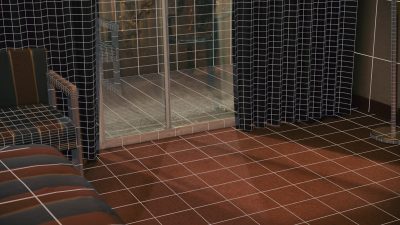
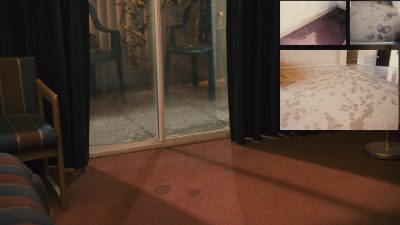
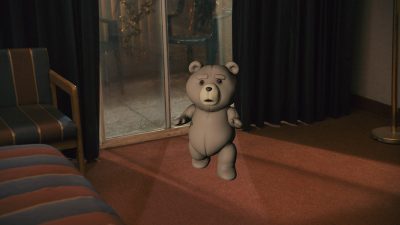
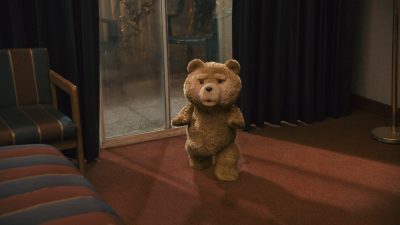
Tippett and Iloura, which do have different effects pipelines, were able to work together to swap and match their bear animations and renders just as reference, even down to the worn spots on Ted. Both studios animated in Maya, but Tippett uses RenderMan for rendering while Iloura relies on V-Ray and 3Delight. Each studio also had a slightly different fur set-up but ultimately produced similar passes for comp.
For example, Iloura VFX supe Glenn Melenhurst explains his studio’s approach: “We’d use V-Ray to light a ‘nude’ bear and get all the lovely shading and elements and then propagate that solve up through the hair in 3Delight so it got the same GI feel. Then on top of that was all the direct lights on the hair shader itself – back scattering and specularity.”
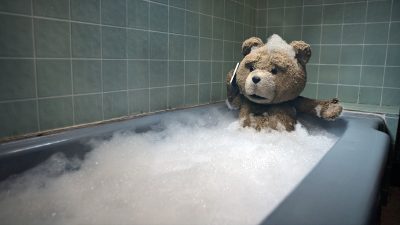
“It was an effective combo of using ray-tracing renderer for what it’s good for and using RenderMan compliant renderer 3Delight for fur,” adds lloura CG supervisor Avi Goodman. For the fur we had a map-based system that we use with guides we groom in the viewpoint.”
The studios also kept the character rigged relatively simply to depict a toy that was alive, but still just a toy. “He was rigged like a normal character but then there was a cloth solve on the actual bear as well,” says Melenhurst. “You’d twist his arm and it would twist with normal mass and weight, but then on top of that were all the soft rolls of fabric that would make him feel like he was a toy.”
Some memorable scenes
Tippett’s key scenes included the hotel fight, a couch smoking scene with John, an encounter with hookers, shots at the supermarket where Ted gets a job, an end sequence where a torn-up Ted comes back to life, and many others. Notable Iloura contributions included scenes featuring a young Ted, Ted in a bath, party scenes, an elaborate chase sequence at Fenway Park in Boston, and the film’s opening shot: an all-in-one swoop down from the Universal logo into a neighborhood scene of kids having a snowball fight that proved more challenging than initially thought.
Previsualizing Ted.“We were going to use some cloud cover to do the transition from space to the neighborhood,” outlines Blair Clark. “Then we found out in the last couple of months that the new Universal opening logo was being re-designed (by Weta Digital). One of the big changes was that the new logo is Earth in darkness, so all the land masses are formed by the lights from homes. But Iloura had to segue into a daytime view of snow!”
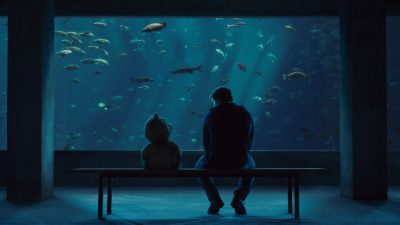
“We actually got the Universal assets fresh off Weta Digital’s renderfarm,” explains Iloura’s Goodman. “We had to transfer off their digital globe to our own digital asset and push in past the logo right down to street level in daylight without pushing through any clouds or anything.”
Iloura also worked on a key scene of John and his girlfriend Lori (Mila Kunis) having dinner with Ted and his partner Tami-Lynn (Jessica Barth). The actors performed with an empty seat for Ted, while MacFarlane sat nearby on an oversized table with oversized cutlery and crockery, wearing the MVN suit and delivering the lines. Iloura then inserted their CG Ted plus digital props like beer and food. “All the ebb and flow of the conversation was there and quite natural,” notes Goodman. “And actually, in a review, Seth used the term, ‘I can’t believe it, it’s so fucking ordinary, it’s perfect.’ He didn’t want to make a fuss about it being a CG character – he just wanted Ted to be another member of the dinner party.”
All images and clips copyright © 2012 Universal Pictures.

Pingback: Soraya Sperandio
Pingback: Almost more than you can bear: the VFX of Ted 2 | SKYFLUX
Pingback: TED 2: | nwonewworld